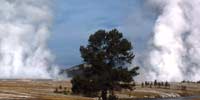Lewis & Clark: Yellowstone Geysers


 4:13
Barrett Golding
4:13
Barrett Golding
The Park’s geyser guy takes us on a tour.
Broadcast: Sep 27 2006 on PRX Nature Stories Podcast; Aug 12 2005 on NPR Day to DaySeries: Lewis & Clark Trail: 200 Years Later Subjects: Environment, Science
Profile: The geysers of Yellowstone Park
August 12, 2005 from Day to Day
ALEX CHADWICK, host: OK. We're gonna close with a feature from memory. Here's the background. This summer, the National Park Service says more than two million people will visit Yellowstone; that's America's first and most famous national park. The main attraction there are the geysers and the hot springs. There are more than 120 of these thermal features, Old Faithful being the most popular. For 26 years, Rick Hutchinson was known simply as `the geyser guy' at Yellowstone. He was a geologist and a naturalist and the world's foremost authority on geysers. He died several years ago, 1997, but before his death--and here's the memory part--producer Barrett Golding went on a tour with Rick Hutchinson through Yellowstone's geyser basins.
(Soundbite of recording)
Mr. RICK HUTCHINSON (Research Geologist, Yellowstone National Park): Watch the surface. You've got an area over 2 meters across where the whole ground is pulsating.
(Soundbite of geyser)
Mr. HUTCHINSON: Now begins the eruption.
(Soundbite of geyser)
Mr. HUTCHINSON: And now it's over; a nice, short one. It's, you know, just a very, very narrow slit in the rock, so then that the water that's in the geyser starts flashing or exploding into steam. And those explosions pushing the water out is what causes the eruption.
(Soundbite of geyser; radio chatter)
Mr. HUTCHINSON: Under Yellowstone, there's a zone of partially molten rock left over from the last big cold air eruption a little over 600,000 years ago that created a crater that was 45 kilometers wide and 75 kilometers long and dumped volcanic ash and drifts in eastern Nebraska and South Dakota and Kansas and some places more than 6 meters deep. And then following that big eruption, we've had volcanic activity continuously since.
(Soundbite of geyser)
Mr. HUTCHINSON: And then rainwater and snowmelt seeps down into the volcanic plateau here. The volcanic rock is very, very porous and it goes down to near where the semimolten rock is and gets heated.
(Soundbite of geyser)
Mr. HUTCHINSON: Right now the geyser tube is slowly filling. You can see that the water's almost to the top of the vent.
(Soundbite of geyser)
Mr. HUTCHINSON: It's fun feeling the ground shake underneath you when a powerful geyser goes off or getting coated by ice in the winter as the wind shifts and the spray of a geyser lands on your coat.
(Soundbite of geyser)
Mr. HUTCHINSON: The areas of geysers in the world are very, very rare. There's geysers in New Zealand, Iceland, Kamchatka in eastern Siberia and then at very, very high elevations in Tibet. But you add up all the other geysers in the world, there are fewer than what's here in Yellowstone. Most of the other areas of the world where there are geysers is being destroyed by the extraction of heat and water through geothermal development, for energy, space heating, electrical power.
(Soundbite of footsteps)
Mr. HUTCHINSON: This place is protected.
(Soundbite of footsteps)
CHADWICK: That's Rick Hutchinson. He was a research geologist and geyser expert at Yellowstone National Park for more than 26 years. Rick died in 1997. Thanks to producer Barrett Golding at HearingVoices.com.
And DAY TO DAY is a production of NPR News with contributions from slate.com. I'm Alex Chadwick.

